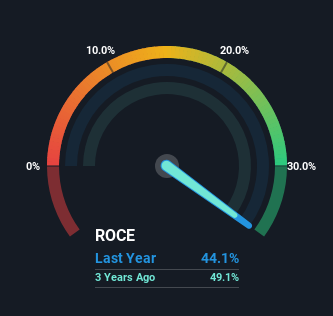If you're looking for a multi-bagger, there's a few things to keep an eye out for. Typically, we'll want to notice a trend of growing return on capital employed (ROCE) and alongside that, an expanding base of capital employed. Put simply, these types of businesses are compounding machines, meaning they are continually reinvesting their earnings at ever-higher rates of return. And in light of that, the trends we're seeing at AutoZone's (NYSE:AZO) look very promising so lets take a look.
What Is Return On Capital Employed (ROCE)?
For those that aren't sure what ROCE is, it measures the amount of pre-tax profits a company can generate from the capital employed in its business. The formula for this calculation on AutoZone is:
Return on Capital Employed = Earnings Before Interest and Tax (EBIT) ÷ (Total Assets - Current Liabilities)
0.44 = US$3.8b ÷ (US$17b - US$8.9b) (Based on the trailing twelve months to November 2024).
So, AutoZone has an ROCE of 44%. In absolute terms that's a great return and it's even better than the Specialty Retail industry average of 13%.
See our latest analysis for AutoZone

In the above chart we have measured AutoZone's prior ROCE against its prior performance, but the future is arguably more important. If you'd like, you can check out the forecasts from the analysts covering AutoZone for free.
The Trend Of ROCE
Investors would be pleased with what's happening at AutoZone. Over the last five years, returns on capital employed have risen substantially to 44%. The company is effectively making more money per dollar of capital used, and it's worth noting that the amount of capital has increased too, by 26%. This can indicate that there's plenty of opportunities to invest capital internally and at ever higher rates, a combination that's common among multi-baggers.
On a separate but related note, it's important to know that AutoZone has a current liabilities to total assets ratio of 51%, which we'd consider pretty high. This effectively means that suppliers (or short-term creditors) are funding a large portion of the business, so just be aware that this can introduce some elements of risk. Ideally we'd like to see this reduce as that would mean fewer obligations bearing risks.
In Conclusion...
All in all, it's terrific to see that AutoZone is reaping the rewards from prior investments and is growing its capital base. And a remarkable 180% total return over the last five years tells us that investors are expecting more good things to come in the future. So given the stock has proven it has promising trends, it's worth researching the company further to see if these trends are likely to persist.
If you want to know some of the risks facing AutoZone we've found 3 warning signs (2 are potentially serious!) that you should be aware of before investing here.
High returns are a key ingredient to strong performance, so check out our free list ofstocks earning high returns on equity with solid balance sheets.
New: Manage All Your Stock Portfolios in One Place
We've created the ultimate portfolio companion for stock investors, and it's free.
• Connect an unlimited number of Portfolios and see your total in one currency
• Be alerted to new Warning Signs or Risks via email or mobile
• Track the Fair Value of your stocks
Have feedback on this article? Concerned about the content? Get in touch with us directly. Alternatively, email editorial-team (at) simplywallst.com.
This article by Simply Wall St is general in nature. We provide commentary based on historical data and analyst forecasts only using an unbiased methodology and our articles are not intended to be financial advice. It does not constitute a recommendation to buy or sell any stock, and does not take account of your objectives, or your financial situation. We aim to bring you long-term focused analysis driven by fundamental data. Note that our analysis may not factor in the latest price-sensitive company announcements or qualitative material. Simply Wall St has no position in any stocks mentioned.
About NYSE:AZO
AutoZone
AutoZone, Inc. retails and distributes automotive replacement parts and accessories in the United States, Mexico, and Brazil.
Limited growth with questionable track record.
Similar Companies
Market Insights
Community Narratives



